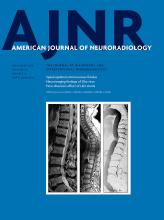Index by author
Gallmann, W.
- Spine Imaging and Spine Image-Guided InterventionsYou have accessSpinal Coccidioidomycosis: MR Imaging Findings in 41 PatientsR.N. Crete, W. Gallmann, J.P. Karis and J. RossAmerican Journal of Neuroradiology November 2018, 39 (11) 2148-2153; DOI: https://doi.org/10.3174/ajnr.A5818
Ganesan, V.
- FELLOWS' JOURNAL CLUBPediatric NeuroimagingOpen AccessExpanding the Distinctive Neuroimaging Phenotype of ACTA2 MutationsF. D'Arco, C.A. Alves, C. Raybaud, W.K.K. Chong, G.E. Ishak, S. Ramji, M. Grima, A.J. Barkovich and V. GanesanAmerican Journal of Neuroradiology November 2018, 39 (11) 2126-2131; DOI: https://doi.org/10.3174/ajnr.A5823
Patients with the ACTA2 mutation have distinctive clinical and angiographic features—specifically, a combination of ectasia and stenosis, a straight arterial course, absence of basal collaterals, and more widespread cerebrovascular involvement in comparison with Moyamoya disease. Neuroimaging studies from 13 patients with heterozygous Arg179His mutations in ACTA2 and 1 patient with pathognomonic clinicoradiologic findings for ACTA2 mutation were retrospectively reviewed. Characteristic bending and hypoplasia of the anterior corpus callosum, apparent absence of the anterior gyrus cinguli, and radial frontal gyration were present in 100% of the patients; flattening of the pons on the midline and multiple indentations in the lateral surface of the pons were demonstrated in 93% of the patients.
Gano, D.
- EDITOR'S CHOICEPediatric NeuroimagingOpen AccessAberrant Structural Brain Connectivity in Adolescents with Attentional Problems Who Were Born PrematurelyO. Tymofiyeva, D. Gano, R.J. Trevino, H.C. Glass, T. Flynn, S.M. Lundy, P.S. McQuillen, D.M. Ferriero, A.J. Barkovich and D. XuAmerican Journal of Neuroradiology November 2018, 39 (11) 2140-2147; DOI: https://doi.org/10.3174/ajnr.A5834
The purpose of this study was to identify the neural correlates of attentional problems in adolescents born prematurely and determine neonatal predictors of those neural correlates and attention problems. Of the 24 subjects, 12 had attention deficits. A set of axonal pathways connecting the frontal, parietal, temporal, and occipital lobes had significantly lower fractional anisotropy in subjects with attentional problems. The temporoparietal connection between the left precuneus and left middle temporal gyrus was the most significantly underconnected interlobar axonal pathway. Low birth weight and ventriculomegaly, but not white matter injury or intraventricular hemorrhage on neonatal MR imaging, predicted temporoparietal hypoconnectivity in adolescence.
Gascou, G.
- NeurointerventionYou have accessFlow-Diversion Effect of LEO Stents: Aneurysm Occlusion and Flow Remodeling of Covered Side Branches and PerforatorsF. Cagnazzo, M. Cappucci, C. Dargazanli, P.-H. Lefevre, G. Gascou, C. Riquelme, R. Morganti, V. Mazzotti, A. Bonafe and V. CostalatAmerican Journal of Neuroradiology November 2018, 39 (11) 2057-2063; DOI: https://doi.org/10.3174/ajnr.A5803
- NeurointerventionYou have accessTreatment of Intracranial Aneurysms with Self-Expandable Braided Stents: A Systematic Review and Meta-AnalysisF. Cagnazzo, M. Cappucci, P.-H. Lefevre, C. Dargazanli, G. Gascou, R. Morganti, V. Mazzotti, D. di Carlo, P. Perrini, D. Mantilla, C. Riquelme, A. Bonafe and V. CostalatAmerican Journal of Neuroradiology November 2018, 39 (11) 2064-2069; DOI: https://doi.org/10.3174/ajnr.A5804
Gellissen, S.
- Adult BrainYou have accessImpact of Ischemic Lesion Location on the mRS Score in Patients with Ischemic Stroke: A Voxel-Based ApproachM. Ernst, A.M.M. Boers, N.D. Forkert, O.A. Berkhemer, Y.B. Roos, D.W.J. Dippel, A. van der Lugt, R.J. van Oostenbrugge, W.H. van Zwam, E. Vettorazzi, J. Fiehler, H.A. Marquering, C.B.L.M. Majoie and S. Gellissen on behalf of the MR CLEAN trial investigators (www.mrclean-trial.org)American Journal of Neuroradiology November 2018, 39 (11) 1989-1994; DOI: https://doi.org/10.3174/ajnr.A5821
Glass, H.C.
- EDITOR'S CHOICEPediatric NeuroimagingOpen AccessAberrant Structural Brain Connectivity in Adolescents with Attentional Problems Who Were Born PrematurelyO. Tymofiyeva, D. Gano, R.J. Trevino, H.C. Glass, T. Flynn, S.M. Lundy, P.S. McQuillen, D.M. Ferriero, A.J. Barkovich and D. XuAmerican Journal of Neuroradiology November 2018, 39 (11) 2140-2147; DOI: https://doi.org/10.3174/ajnr.A5834
The purpose of this study was to identify the neural correlates of attentional problems in adolescents born prematurely and determine neonatal predictors of those neural correlates and attention problems. Of the 24 subjects, 12 had attention deficits. A set of axonal pathways connecting the frontal, parietal, temporal, and occipital lobes had significantly lower fractional anisotropy in subjects with attentional problems. The temporoparietal connection between the left precuneus and left middle temporal gyrus was the most significantly underconnected interlobar axonal pathway. Low birth weight and ventriculomegaly, but not white matter injury or intraventricular hemorrhage on neonatal MR imaging, predicted temporoparietal hypoconnectivity in adolescence.
Granberg, T.
- Adult BrainOpen AccessDetection of Leukocortical Lesions in Multiple Sclerosis and Their Association with Physical and Cognitive Impairment: A Comparison of Conventional and Synthetic Phase-Sensitive Inversion Recovery MRIY. Forslin, Å. Bergendal, F. Hashim, J. Martola, S. Shams, M.K. Wiberg, S. Fredrikson and T. GranbergAmerican Journal of Neuroradiology November 2018, 39 (11) 1995-2000; DOI: https://doi.org/10.3174/ajnr.A5815
Grewal, S.S.
- FunctionalYou have accessCorticopallidal Connectome of the Globus Pallidus Externus in Humans: An Exploratory Study of Structural Connectivity Using Probabilistic Diffusion TractographyS.S. Grewal, V.M. Holanda and E.H. MiddlebrooksAmerican Journal of Neuroradiology November 2018, 39 (11) 2120-2125; DOI: https://doi.org/10.3174/ajnr.A5816
Grima, M.
- FELLOWS' JOURNAL CLUBPediatric NeuroimagingOpen AccessExpanding the Distinctive Neuroimaging Phenotype of ACTA2 MutationsF. D'Arco, C.A. Alves, C. Raybaud, W.K.K. Chong, G.E. Ishak, S. Ramji, M. Grima, A.J. Barkovich and V. GanesanAmerican Journal of Neuroradiology November 2018, 39 (11) 2126-2131; DOI: https://doi.org/10.3174/ajnr.A5823
Patients with the ACTA2 mutation have distinctive clinical and angiographic features—specifically, a combination of ectasia and stenosis, a straight arterial course, absence of basal collaterals, and more widespread cerebrovascular involvement in comparison with Moyamoya disease. Neuroimaging studies from 13 patients with heterozygous Arg179His mutations in ACTA2 and 1 patient with pathognomonic clinicoradiologic findings for ACTA2 mutation were retrospectively reviewed. Characteristic bending and hypoplasia of the anterior corpus callosum, apparent absence of the anterior gyrus cinguli, and radial frontal gyration were present in 100% of the patients; flattening of the pons on the midline and multiple indentations in the lateral surface of the pons were demonstrated in 93% of the patients.








